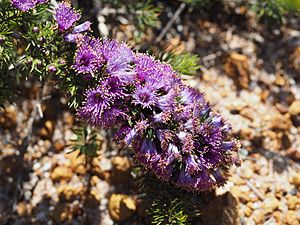Eremaea violacea facts for kids
Quick facts for kids Eremaea violacea |
|
|---|---|
 |
|
| Eremaea violacea growing in Lesueur National Park | |
| Scientific classification | |
| Genus: |
Eremaea (plant)
|
| Species: |
violacea
|
| Synonyms | |
|
Melaleuca kybeliona Craven & R.D.Edwards |
|
Eremaea violacea is a beautiful plant that belongs to the myrtle family, called Myrtaceae. This plant is special because it is endemic to the south-west part of Western Australia. This means it naturally grows only in that area. It is a low, spreading shrub with narrow, somewhat prickly leaves. You can spot it by its lovely violet-coloured flowers that grow on short branches.
Contents
What Eremaea violacea Looks Like
Eremaea violacea is a shrub that spreads out or grows very low to the ground. It can reach about 1 meter (3.3 feet) tall. Its younger branches are covered with many fine hairs.
The leaves of this plant are long and thin, or sometimes shaped like a narrow egg. They are about 7 to 12 millimeters (0.28 to 0.47 inches) long and 0.4 to 1.2 millimeters (0.016 to 0.047 inches) wide. Depending on the type of Eremaea violacea, the leaves can be flat or round when you look at their cross-section (if you cut them in half). This difference in leaf shape helps tell the two types apart.
Flowers and Fruits
As its name suggests, the flowers of Eremaea violacea are a pretty violet colour. They grow in groups of up to 7 flowers on short side branches. These short branches grow from longer ones that appeared the year before.
Each flower has 5 sepals, which are small leaf-like parts that protect the flower bud. These sepals are usually hairy on the outside. There are also 5 petals, which are the colourful parts of the flower, about 2.3 to 4.5 millimeters (0.091 to 0.177 inches) long. Inside the flower, the stamens (the parts that make pollen) are grouped into 5 bundles. Each bundle has 24 to 32 stamens.
Eremaea violacea usually flowers from September to October. After the flowers, the plant produces woody capsules, which are like small seed pods. These capsules are about 5 to 8 millimeters (0.20 to 0.31 inches) long and 6 to 7.5 millimeters (0.24 to 0.30 inches) wide. They are shaped like a cup or are almost round and have a smooth outer surface.
Naming and Plant Families
The plant Eremaea violacea was first officially described in 1878 by a scientist named Ferdinand von Mueller. He wrote about it in his book Fragmenta Phytographiae Australiae. The second part of its scientific name, violacea, comes from the Latin word violaceus, which means "having a purple colour." This perfectly describes its violet flowers!
Different Types of Eremaea violacea
There are two main types, or subspecies, of Eremaea violacea:
- Eremaea violacea var. violacea: This type has flat leaves. You can find it only in areas between the Irwin and Greenough rivers.
- Eremaea violacea subsp. raphiophylla: This type has long, thin, round leaves, like a cylinder. It grows between the Arrowsmith and Hill rivers.
Where Eremaea violacea Grows
Eremaea violacea is found in a region of Western Australia called the Irwin district. This area includes the Geraldton Sandplains and Swan Coastal Plain biogeographic regions. It likes to grow in sandy soil, sandy clay, or soils that come from laterite (a type of reddish soil). You can often see it on sandplains, ridges, and even along roadsides.
Looking After Eremaea violacea
Both types of Eremaea violacea are doing well. The Western Australian Government's Department of Parks and Wildlife has classified them as "not threatened." This means they are not currently in danger of disappearing.
Images for kids


